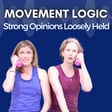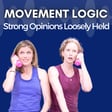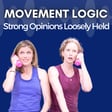
93: Should You Avoid Spinal Flexion with Osteoporosis?
In this episode of the Movement Logic Podcast, hosts Laurel Beversdorf and Dr. Sarah Court critically examine common beliefs surrounding spinal flexion exercises and osteoporosis, particularly from a yoga and Pilates perspective. They delve into two pivotal studies on exercise and fracture risk, both led by Dr. Mehrsheed Sinaki, a renowned specialist in physical medicine and rehabilitation at the Mayo Clinic in Rochester, Minnesota.
The first study, Postmenopausal Spinal Osteoporosis: Flexion versus Extension Exercises, is frequently cited on Pilates websites and in yoga and Pilates teacher trainings as evidence that spinal flexion is risky for individuals with osteoporosis—even during bodyweight exercises. However, despite its widespread use to justify movement restrictions, the study has notable methodological flaws. The second study, Stronger Back Muscles Reduce the Incidence of Vertebral Fractures: A Prospective 10-Year Follow-up of Postmenopausal Women, suggests that progressively overloaded back strengthening exercises can reduce fracture risk—even if the strengthening occurred only for a few years in the distant past. Yet, this study also has its own limitations.
When viewed together, these studies present an intriguing contrast: one warns of the potential dangers of spinal flexion (even under low loads) based on weak evidence, while the other highlights the lasting protective benefits of strength training. Laurel and Sarah explore why bodyweight spinal flexion is often singled out as risky and question whether this caution is always justified.
They also discuss the ethical implications and the boundaries of a movement teacher's scope of practice—particularly when making broad recommendations to avoid certain movements based on limited or flawed research. The hosts emphasize the importance of individualized context in exercise prescriptions, the need to follow medical guidance from a student’s doctor, the evidence-backed benefits of strength training, and the necessity of empowering students with the autonomy to make informed movement choices.
Get on the wait list for our Bone Density Course: Lift for Longevity
Follow Movement Logic on Instagram
00:56 Podcast Production & Content Creation
01:33 Bone Density & Squat Depth
02:20 Benefits of Full ROM Strength Training
08:24 Is Spinal Flexion Dangerous for OP?
10:00 Issues with Yoga/Pilates for OP Classes
18:43 1984 Paper: Flexion vs. Extension for OP
40:22 Flaws in the 1984 Study
41:57 2002 Study: Stronger Back Muscles & Fractures
43:03 2002 Study Design & Methods
46:35 2002 Study Key Findings
52:09 2002 Study Limitations
56:30 Practical Takeaways
01:06:15 Ethics for Movement Teachers
01:17:43 Conclusion
References:


